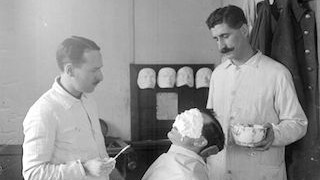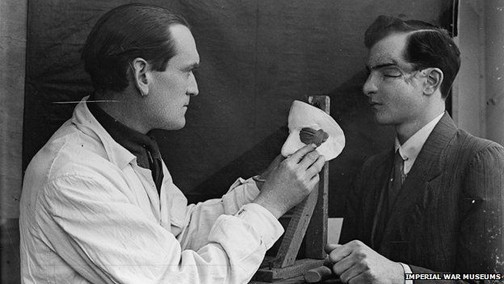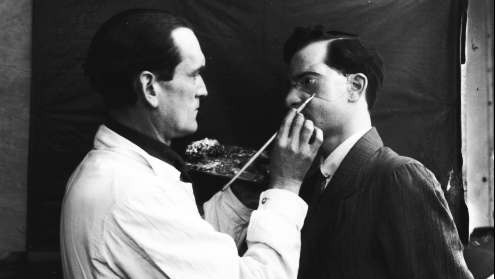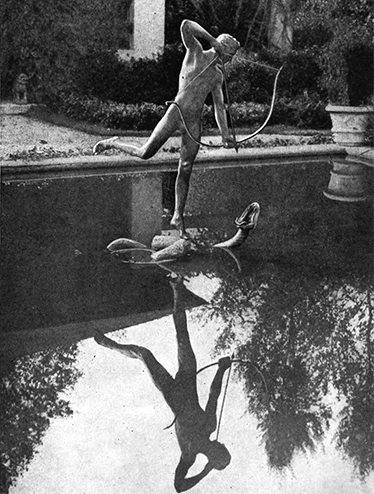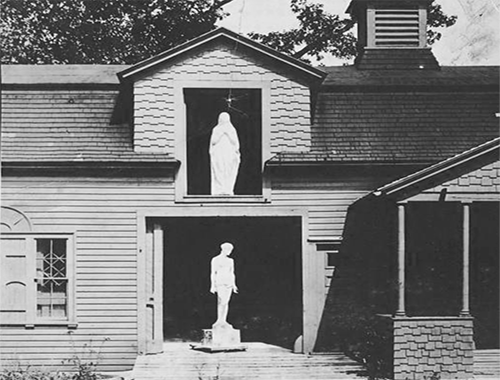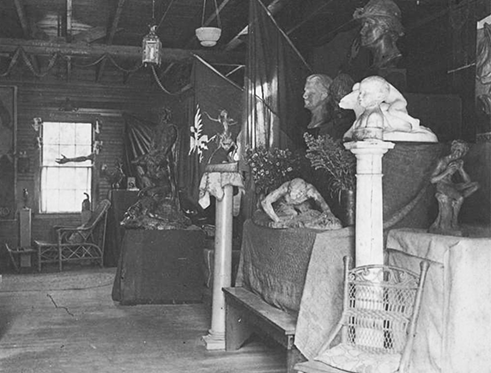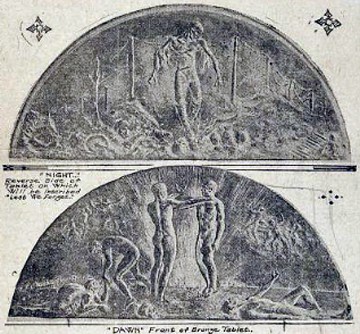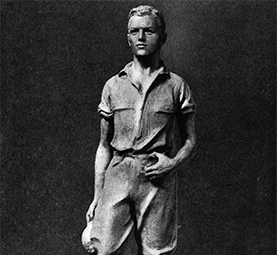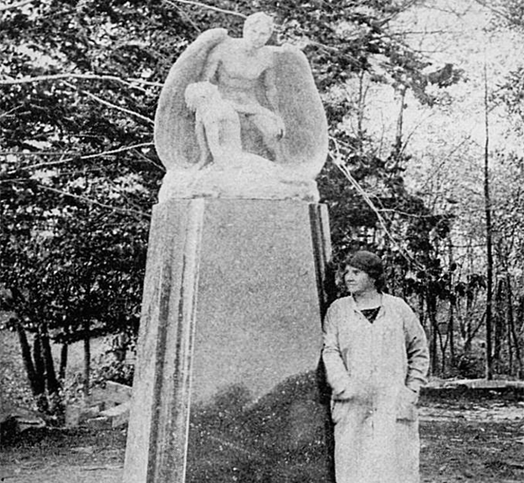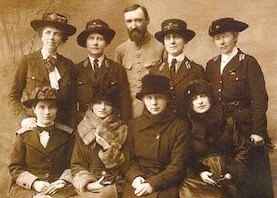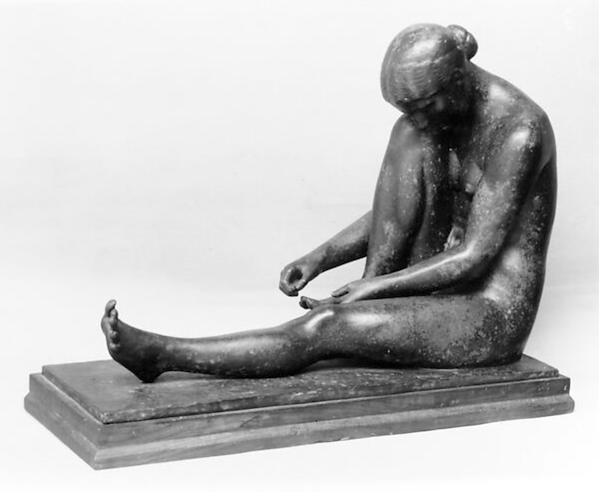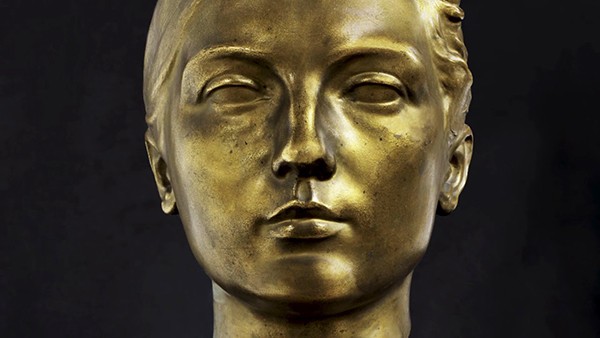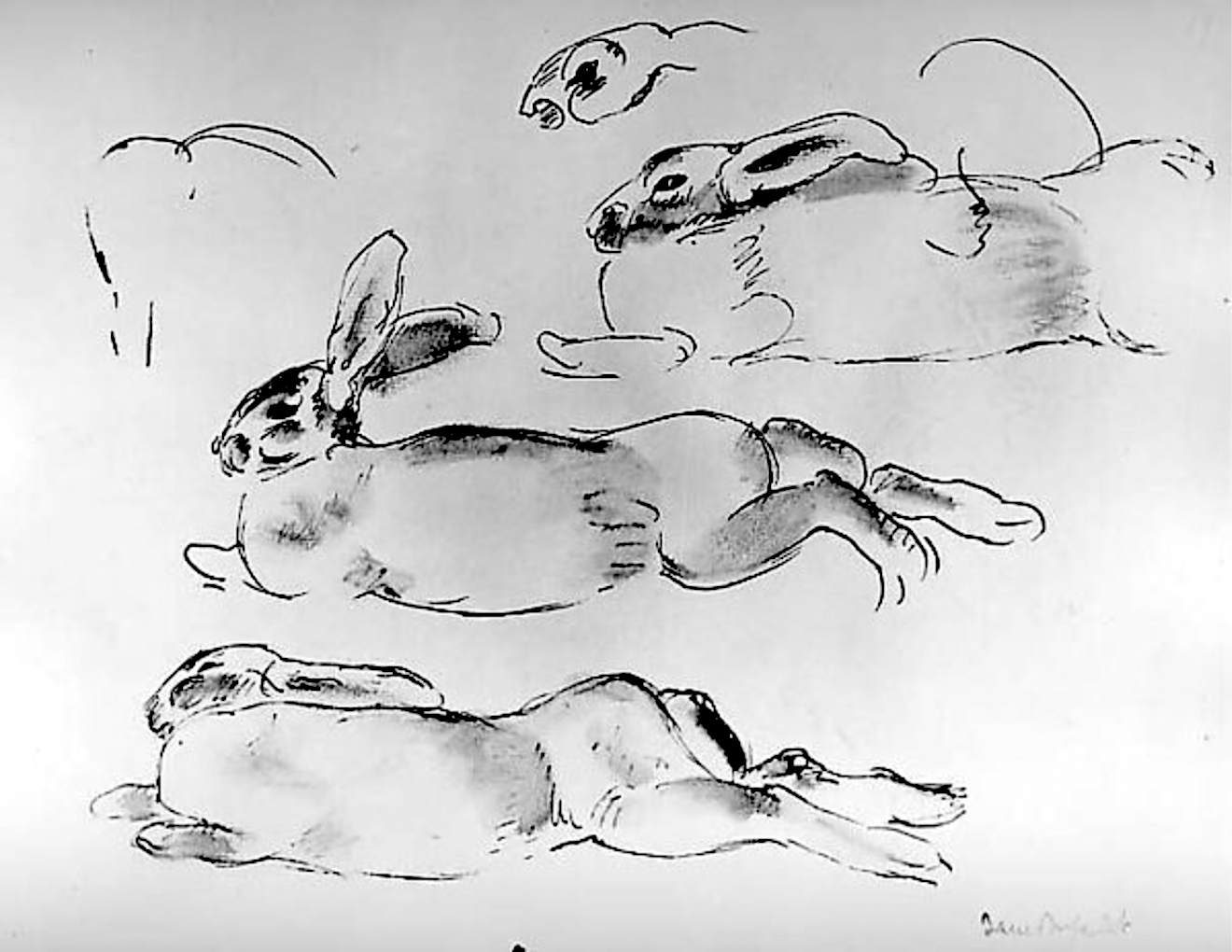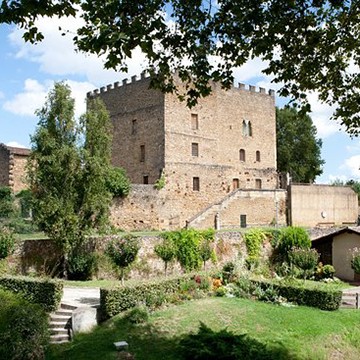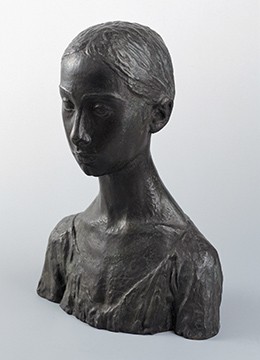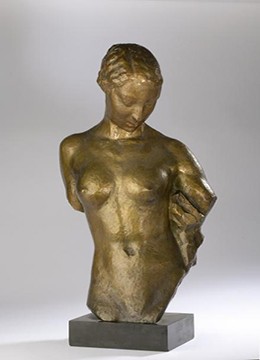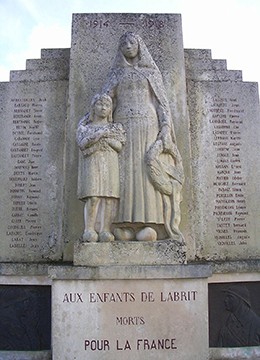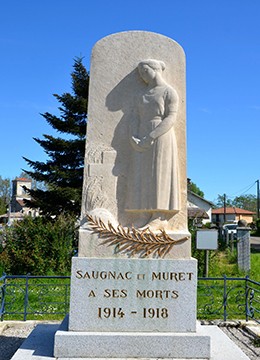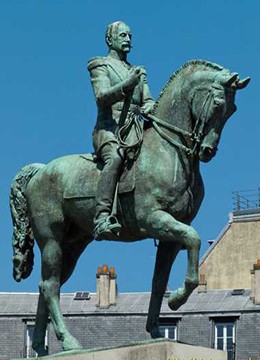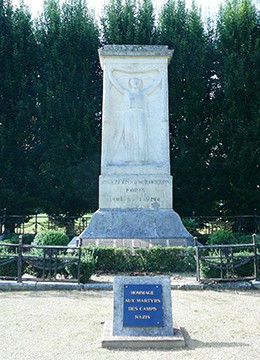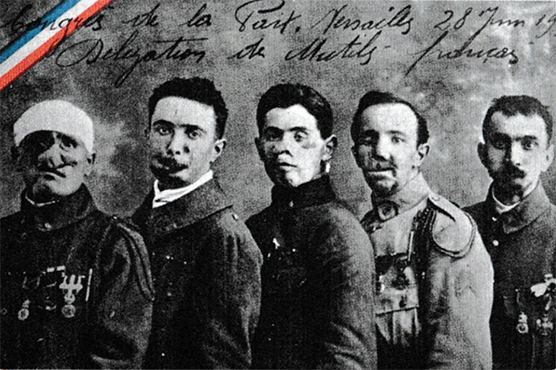
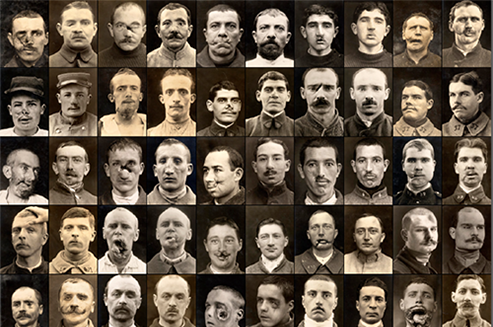
In the aftermath of WWI, it would take years to rebuild France’s infrastructure, economy, social fabric, and people. Among its numerous reconstruction initiatives, the ARC supported and partially financed a project to outfit wounded soldiers with facial prosthetics – they were victims of machine-gunfire, bombs, and grenade explosions. An estimated three million men were wounded between 1914 and 1918, of whom 15,000 – 20,000 suffered facial injuries that forever altered the course of their lives. Marie-Andrée Roze-Pellat remarked in a 2014 article that the memory of World War I "[...] persists in time because, in no other war, did the fighting inflict such damage to the bodies of the soldier” (translated from the French 41).
Disfigured soldiers were dismissively assigned the title of “les gueules cassées” (the shattered mugs). Prime Minister Georges Clémenceau somberly evoked their grim reality during the signing ceremony of the Treaty of Versailles: “You were in a bad place…It shows” (translated from French, Roze-Pellat 41). After enduring the hardships of warfare, these survivors had returned from the front only to become victims of social stigma, even within their own families. Many were abandoned, living as recluses, only venturing out under the cover of darkness. Although some more “fortunate” veterans benefited from the nascent facial reconstruction techniques of the time, all were irrevocably marked, and in need of support to ease their transitions back into society. Prosthetics enabled this to some degree:
It is [...] in this context of the Great War that maxillofacial surgery was structured as an independent discipline. In Paris, the pioneering department of Dr. Hippolyte Morestin established at the Val-de-Grâce welcomed the 5th division of the facial wounded. However, this medical effort to reconstruct faces left deep scars and permanent damage, and remained insufficient to allow soldiers to return to their social lives. The creation of prostheses was therefore essential and the task was entrusted to dental technicians, but also, to a lesser extent, to sculptors (translated from French, Raingeval 2015, 29).
When the American Red Cross moved its headquarters to 4 rue de Chevreuse, apartments in the immediate vicinity were rented to accommodate nurses, orderlies, and other staff. One such rental was Janet Scudder's studio at 70bis rue Notre-Dame-des-Champs. This studio became the setting of a very special project pioneered by American sculptor Anna Ladd and run under the auspices of the American Red Cross's "Bureau de Reconstruction et de Rééducation des Mutilés de Guerre. Beginning in January 1918, 70bis rue Notre-Dame-des-Champs, renamed the Studio for Portrait Masks, welcomed countless French and American soldiers who had been disfigured in combat. Ladd employed her talents as a painter and sculptor to fashion face masks that would provide these traumatized soldiers with internal and external healing, including the restoration of their self-esteem, which had been ripped from them amid the carnage of the war.
Facial Prosthetics
Facial prosthetics derived from the work of Francis Derwent Wood, a British artist who had volunteered in London hospitals and witnessed the desperation of wounded soldiers. In 1915, he put his artistic skills to use, founding the Masks for Facial Disfigurement Department at the Third London General Hospital, where he became known as a " [...] a pioneer in the field of developing tin masks by taking casts of the wounded man’s face and smoothing over the areas that had been damaged beyond surgical repair" (Prichard 38). His unfailing commitment to these soldiers lasted well beyond wartime.
American sculptor Anna Coleman Ladd learned of Wood’s practice through British art critic C. Lewis Hund, who gave her an article by Wood explaining his technique. She visited his "Tin Noses Shop” in 1917, and he encouraged her to employ her own artistic talents in fashioning such masks for French soldiers (Keeley 3).
Like many artists of her era, Ladd joined the war effort as a Red Cross volunteer. Inspired by Wood's pioneering work in facial prosthetics, she submitted a proposal to Major Blair of the War Department to establish a prosthetics studio for disfigured French soldiers in Paris, financing it primarily with her own funds. Blair not only praised the proposal but also suggested she extend her work to American soldiers ("Masks for the Wounded"). Ladd's husband, a pediatrician at Harvard University, was appointed Deputy Commissioner of the Children's Bureau of the American Red Cross in Toulouse in late 1917.
The Portrait-Mask Studio is Born
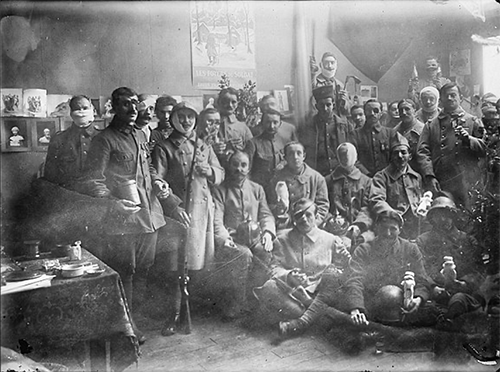
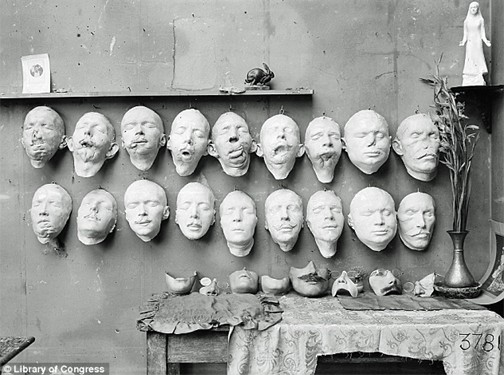
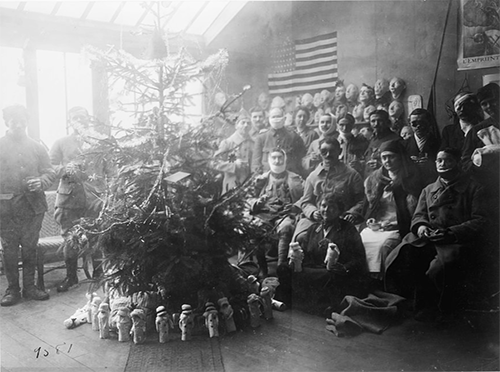
Ladd established the Studio for Portrait Masks in sculptor Janet Scudder's two-room studio at 70bis rue Notre-Dame-des-Champs. Scudder was a former resident of the American Girls’ Art Club and a Red Cross volunteer. The Studio was launched in January 1918, under the auspices of Grace S. Harper of the ARC’s "Bureau de Reconstruction et de Rééducation des Mutilés de Guerre." Financed primarily by Ladd herself, the Studio began as a one-woman operation.
After visiting the Studio, eminent French surgeon Paul Desfossés lauded Ladd’s endeavors in a medical journal:
“All her talent, all her heart, Mrs. Ladd concentrates on those mutilated whose horrible wounds have rendered them unrecognizable event to their mothers. I know well that our surgeons, our Morestins (name of a reputed surgeon), are excellent at reconstructing faces on these formless masses of red flesh; but can they give them back their own features, which a mother, a wife, have loved. The results obtained are truly astonishing: a stupendous illusion of reality […] I advise my surgical colleagues to visit her studio” (cited in “Report on the work of remaking the faces of wounded soldiers” 2).
The Studio's work with disfigured soldiers was quickly recognized as a vital service and Ladd obtained authorization from the French Service de la Santé to make these kinds of masks for wounded soldiers in all ten regions of France:
After four months alone spent in the vicinity of Paris’ hospitals experimenting and holding demonstrations of these first masks before the utmost sculptors, Mrs. Ladd obtained the authorization from the French Service de la Santé to make these for all the ten regions of France, and has already visited Bordeaux and Vichy obtaining more than sixty applications from French mutilés, as well as commencing the work for American ones (“Report on the work of remaking the faces of wounded soldiers” 1).
Studio Team
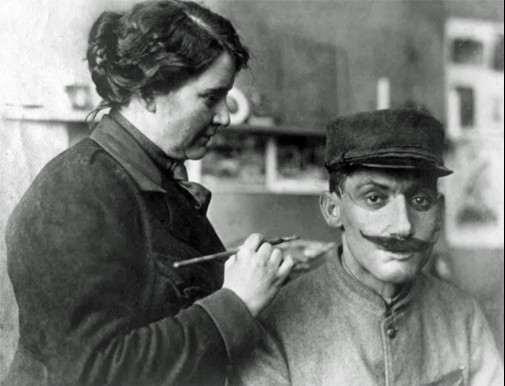
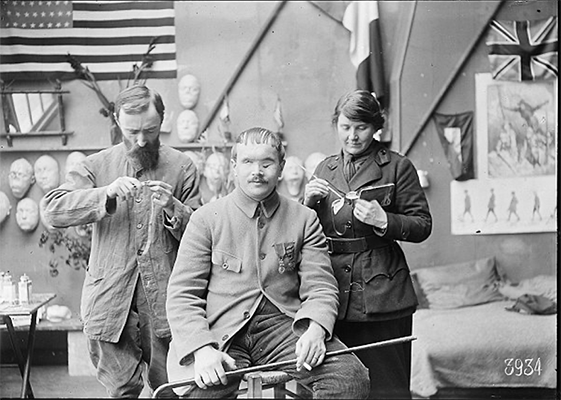
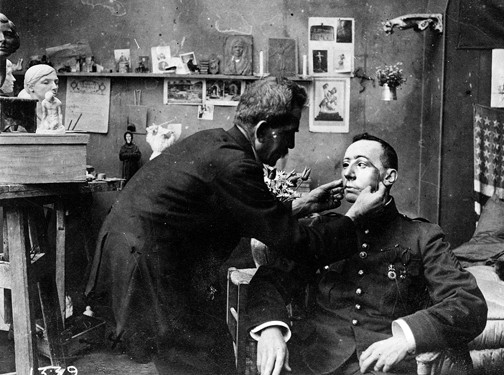
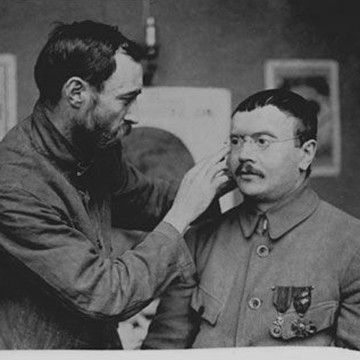
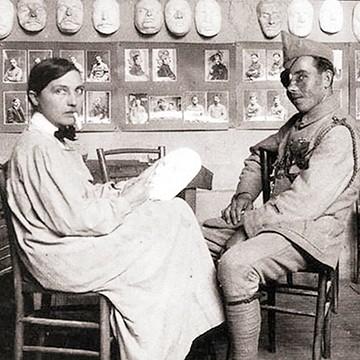
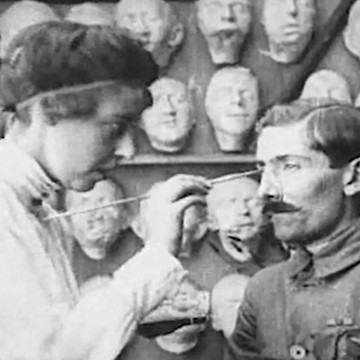
In March 1918, French sculptor Jane Poupelet – a longtime friend of Janet Scudder – joined the Studio. She had previously met Anna Ladd while volunteering for the Red Cross, and had exhibited several series of wooden toys and rag dolls, donating the proceeds to benefit victims of the war (Briot 98). Poupelet brought on board fellow artist Robert Wlérick, whose experience with sculpting molds for Professor Émile Moure’s groundbreaking facial surgery clinic in Bordeaux was especially suited to the needs of the Studio. According to records of the American Red Cross (correspondence from November 1918 to November 1920 and monthly report for October 1919), “Poupelet and Wlérick worked on a part-time basis of five hours a day, to enable them to pursue their own career as sculptors, for a salary of 450 francs a month” (Mitchell, 2005, 65). The Studio also benefited from the help of a certain Miss Blair, curator for specimens for the Harvard Medical Laboratory, who contributed mainly to the galvanization process (Folk 1918).
Artist Marie-Louise Brent joined the Studio in September 1918 as the secretary, overseeing day-to-day administrative logistics, correspondence, and finances. This was a natural transition for her, having already served as the secretary to the American Fund for French Wounded in Lorraine. Managing the Studio alone was no small undertaking for Brent since Anna Ladd was frequently absent, either working in the field or meeting with the heads of various surgical units in France. Additionally, visitors to the Studio often arrived unexpectedly or soldiers would stop by unannounced to have their masks repaired. Social gatherings were also arranged for veterans to meet one another in the Studio’s safe and convivial setting. One such occasion – a Christmas party in 1919 – attracted nearly 140 soldiers and ARC officials (Mixer December 1919, 14).
French and American surgeons praised the Studio and perceived its work as a complement to their own efforts in maxillo-facial surgery. As its reputation grew, referrals began pouring in from hospitals in Paris (Val de Grace, Chaptal, the American Hospital), Rennes, Le Mans, Vichy, Bordeaux, and Neuilly. Soldiers were also referred by ARC officials but many came of their own accord, having heard of the masterful work conducted by the artists from their peers.
Mask-Making Process
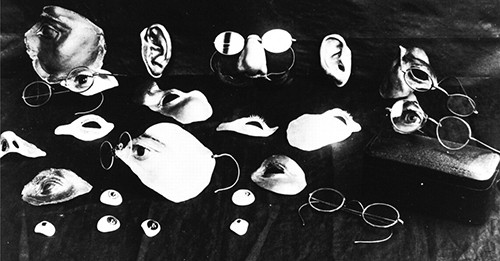
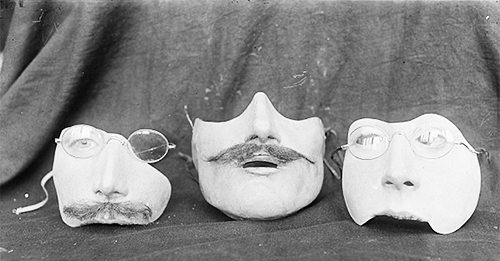
Combining their talents in sculpture, painting, and drawing, the artists at the Studio were an ideal mix of expertise and altruism. According to the American Magazine of Art, “None but an artist who had given much time to portraiture and was peculiarly gifted along these lines could have accomplished such satisfactory results” (309).
After recovering from facial surgery, the men referred to the Studio were asked to provide pre-injury photos, which were then evaluated to determine whether or not a prosthetic could be fashioned:
Our work begins when the surgeon has finished. We do not profess to heal. After the wounded man has been discharged from the hospital we begin our treatment. Of course, the chief difficulty in making these masks is to accurately match both sides of the face and restore the features so that there will be nothing of the grotesque in the appearance of the covering. A mask that did not look like the individual as he was known to his relatives would be almost as bad as the disfigurement (Keeley 3).
The process itself required several sittings, first to make a plaster cast of the soldier’s wounded face, then a second cast, and finally the fitting and painting:
We [...] create, from a photograph of the disfigured person prior to the injury, a second cast, which is the reconstruction of his normal face. To give his face a semblance of what it was, a perfect logic, and its real psychological expression, a medical examination is often necessary: examination of the throat, the structure of the larynx, etc. All this depends, of course, on the nature of the mutilation and the kind of disaster we have to repair. It's on this second cast […] that is modeled the galvanized-mask, which will ultimately be painted directly on the injured man, with an exact rendition of his skin tone. This work requires a series of rather long and rather delicate processes; when it is over, and the adaptation is what it should be, that is to say, narrow, impeccable as far as the case allows, it is difficult to realize that the one who wears this mask thus connected to his features, is, most of the time, completely disfigured (translated from French, Wlérick cited in Junka 11).
To source the galvanized copper prostheses, the Studio worked with Christofle, a renowned goldsmithing firm established in 1830. The copper was painted with washable enamel paint to match each soldier's skin tone. Eyes and a mustache or beard made of metallic foil were sometimes added. The masks were attached to soldiers’ faces either with glasses, or an almost invisible strip hooked behind the ears, or even a small amount of spirit gum. They could be removed during meals or sleep, and the lips were always left slightly open so the person could speak or smoke. Mask recipients were also given recipes for drinks, soups, and creams, all of which were easier to ingest via the lips’ small opening, so that they did not always have to remove their masks (Ladd, Cookery Receipts):
A masking was considered successful when the patient could walk down a Parisian boulevard without being noticed. Earlier, after their multiple surgeries were complete but before they were fitted with masks, the men had gone on supervised forays into the city, accompanied by their nurses, only to find that onlookers gawked at them and sometimes even fainted. The men called this the Medusa effect. The masks allowed them to regain some measure of the social visibility they had forfeited because of their ghastly wounds (Lubin 2008, 11).
Initially, the advantages of portrait masks were highly contested (Feo 25), especially since many soldiers received only one – with a limited shelf-life – and they often caused facial irritations and other inconveniences (Delaporte 121-122):
The reality is not so miraculous. First of all, from a practical point of view, the masks and prostheses all had drawbacks, whether they were made of gelatin, plastic, vulcanite or painted metal. They could very quickly lose their original color, inducing a humiliating difference between the complexion of the mask and that of the face. They often had to be restored or even replaced. Finally, wearing items made of copper or containing glue could cause severe skin irritation, not to mention the inconvenience due to their weight. This is why the enthusiasm generated by the prostheses could sometimes quickly give way to disappointment and resignation, the cripple resolving to show his face as it is. Historians Sophie Delaporte and Katherine Feo thus consider that the use of facial prostheses has ultimately constituted a relatively marginal solution (Ackerman 17).
As Ladd and the other Studio artists gained experience, the dreaded full face coverings were replaced with lighter masks that sheathed only injuries and more easily blended into each visage. Additionally, the enamel paint, which was gifted to the ARC by the Celluloid Zapon Company in Connecticut (Celluloid letter to Treasurer of ARC and McGovern letter to Brent) was regularly improved so as to ensure its durability. According to Wlérick, these upgraded masks were unalterable and could last indefinitely if the soldiers took good care of them (cited in Junka 12).
Ladd and the ARC received a flood of grateful letters, reports, and poems from French surgeons, as well as from soldiers and their families. Several of these testimonials were cited in Knowlton Mixer’s December 1919 report to ARC officials:
The masks are so thin and light that one man wrote he forgot to take it off at night. Another said that the police no longer demanded to see his papers daily, as they did not suspect them of being a mutilé. (1)
Thanks to you, the despairing rejoice, the damned return to hope, the gentle wives and mothers will again find the faces they wept for… What Sculptor could do more? And by what precious and new words can one thank you? (13)
These masks are as interesting from the artistic, as from the practical standpoint. They permit mutilated men, awaiting operations or whose wounds are beyond the resources of surgery, to circulate without attracting attention, or without being the object of repulsion to those even who most appreciate their admirable conduct. I offer you my sincere thanks for those especially disinherited ones…(12).
Studio's Evolution
Though she had labored assiduously in Paris for eleven months, Ladd lacked the necessary funds to continue her work in the Studio. She returned to Boston in early December 1918. Her husband was also free to reopen his prewar medical practice as the Children's Division of the ARC was progressively shutting down activities.
On the eve of her departure, Dr. Léon Dufourmontel from the Rennes Center for maxillo-facial reconstruction, who had sent several patients to the Studio, wrote Ladd to express his admiration for her work:
Your upcoming departure for America will be regretted by many French people who have appreciated your very active devotion. I too hope to be able to one day visit your country which has garnered so much sympathy and friendship here. Will I have the joy of decorating my living room with a sample of your talent? I will come to Paris next week and would be happy to receive it from your very hands (translated from French).
Anna Ladd left behind lists of the names of soldiers to whom she had delivered masks and those who were still waiting to be outfitted. According to these lists, by November 23, 1918 she had delivered 57 masks and had begun 14 for the 59 new applicants (“List of Portrait Masks Delivered to Date Nov. 23”).
After Ladd’s departure, the Studio came under full Red Cross supervision, with Marie-Louise Brent at the helm, supported by Poupelet and Wlérick. They delivered an additional 10 masks by the end of 1918 (Mixer Report, August 1919, 13).
Circumstances, however, were less than satisfactory, mainly because the studio space belonged to Janet Scudder, who disapproved of Brent’s management style. In her letter to Ladd, Scudder described a rather disastrous operation:
It is one grand pity that you left Paris and I wish that you could come back. Your great work for the French mutilées [sic.] is in the hands of a little person who has the soul of a flea. I suppose Mlle Poupelet has written you frequently and that you know how the work you started in Paris has grown and how more and more mutilées apply for missing features. Often there have been as many as 18 people in the studio at one time, there is not room to turn about in it. Since your departure the place is closed every day until around 2 o’clock and the mutilées are not allowed to enter until that hour. One poor thing came all the way from the provinces to get fixed up. He had just enough money to get here and back, arrived on Saturday afternoon, place was closed until Monday at 2, he did not have money enough to stay, so he went home (May 7, 1919).
Scudder also submitted a long report to Red Cross officials detailing her concerns (Letter to Anna Ladd, May 17, 1919). When Brent received the report, she claimed it "[…] was a deliberate exaggeration, written for the purpose of regaining possession of the studio!" (source)
After quite a bit of back and forth, Brent and the Red Cross managed to secure one of the studios rented by Elisabeth Mills Reid on the ground floor of 86 rue Notre-Dame des-Champs (Hoyt to Brent, April 26, 1919), and Scudder reclaimed her living quarters on May 14, 1919 (Brent Letter to Scudder, May 14, 1919).
Work at this new site continued apace and, in August 1919, the Studio was renamed the Bureau of Portrait Masks. It was placed under the Red Cross Department of General Relief, headed by Knowlton Mixer, whose office was located at 4 rue de Chevreuse (Mixer memo to Brent, August 5, 1919). Wlérick remained with the Bureau until September 1919 and Poupelet through the winter of 1920 (Mitchell 2005, 65). In his August 1919 report on the Bureau’s accomplishments, Mixer recorded that ninety-three masks had been delivered from January 1 to September 1, 1919 (13). He also stated that soldiers who had received masks frequently visited the Bureau, where "they often come to smoke and play games with their friends" (13).
Plans were already underway in September 1919 to transfer the Bureau to French control by the end of the year. For reasons unknown, the Bureau was required to vacate 86 rue Notre-Dame-des-Champs by October 15. After a round of complex negotiations with French authorities, Mixer obtained permission from the Service de la Santé to install it at the Val-de-Grâce hospital (Mixer memo to Olds, December 4, 1919) – a logical site since Dr. Morestin’s service at this hospital had been among the first to recommend soldiers to the original Studio. Brent resigned at the beginning of November, but before her departure, she made sure that the Bureau’s service to the war effort would be memorialized. She sent fifty plaster casts to the ARC Museum in Washington, D.C. (Brent letter to Hunter, September 1, 1919), where they were exhibited along with photos of the men for whom the studio had provided masks (Givenwilson). She also organized the dispatch of an additional three hundred casts.
Mixer hired Emma Leven, who had worked with the ARC in the Paris region, to replace Brent (Mixer letter to Olds, December 4, 1919). Work continued under the auspices of the Red Cross until January 1, 1920. Mixer reported that the Bureau delivered 28 masks in November and 17 more in December (December 1919, 14).
There are few extant sources on the Bureau from this period. Apparently, when it transitioned to the hospital (around December 1919), only Emma Leven and Jane Poupelet continued to work. As a final show of support, the ARC subsidized a Christmas party for disfigured soldiers in 1919 and continued providing supplies for the Bureau through January 1920.
In February, the Val de Grace Hospital hosted the first annual convention of "The Society of the Men with Copper Masks," which included an exhibition of rows of plaster casts and concluded with a dinner and "gifts from America" (“Society of Men Who Have Scars 4).
All Bureau activities ceased with the departure of Jane Poupelet in late 1920.
Studio's Legacy
The work of the Studio/Bureau was obscured with the passage of time, as the practice of camouflaging war injuries was increasingly criticized by soldiers and the general public:
[...] the production of masks can be interpreted a posteriori as one of the cogs in a vast deceptive campaign that sought to minimize and deny the violence and brutality of the war. It is hardly surprising, in this perspective, that some pacifist activists deliberately chose after the war to show broken faces, in all their crudity, in order to attack the society and values that allowed such a conflict to take place [...] (Ackerman 21).
For their contributions to the well-being of French veterans, Wlérick and Poupelet, recognized today as important 20th-century sculptors, were decorated by the French government with the medal of “Chevalier de la Légion d’Honneur” in 1926 and 1928 respectively. Ladd did not receive this recognition until 1932. Poupelet put a veil of silence over her war work, which she perceived as deeply personal. As Mitchell so aptly phrased it:
Poupelet never considered the work she carried out for the Studio of Portrait Masks had formed part of her career as a sculptor. Nor did she feel it was her responsibility to use the practice of sculpture to commemorate the mutilated soldiers for posterity. When The American Red Cross offered a commission, she declined it. The portrait masks had been a form of personal engagement with history when history had left no alternative (48).
After the war, Wlérick accepted commissions to sculpt war memorials, but did not seem to have elaborated on his involvement in the Studio. Ladd, on the other hand, gave multiple talks and press interviews on the Studio’s accomplishments. Despite the abundance of media coverage it received, especially in the United States, the Studio/Bureau and its dedicated artists have been largely overlooked in the historical record.
Interest in the achievements of the Studio for Portrait Masks has been revived in recent years, mainly through the work of Ackerman, Delaporte, Lubin, Mainz, and Mitchell, among others. Whereas numerous websites and scholarly articles address Anna Coleman Ladd’s project, some with admiration and others with critical appraisal, the substantial contributions of Brent, Poupelet, Wlérick, and others are often glossed over.
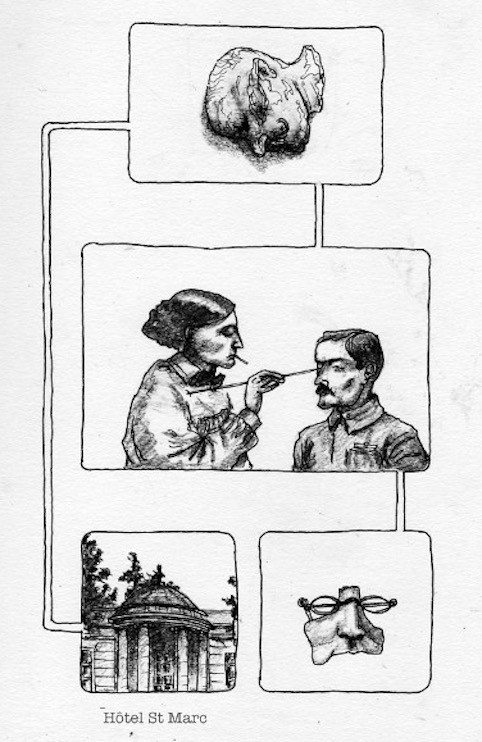
Between 2016 and 2019, the Studio briefly reentered the spotlight when Artists in Residence at a Bordeaux Hospital made an astonishing discovery: several plaster casts and masks they were able to attribute to Jane Poupelet and the Studio for Portrait Masks:
[...] The major discovery made at Saint-Marc was [...] in the abandoned cellars of the mansion. It consisted of several trunks containing the masks of “broken faces,” plaster casts of faces, and the final masks painted with hair, mustaches and fresh complexions. [...] In fear, we contemplate these faces whose gazes stare at us beyond the years, surprised by the hair and mustaches so well preserved despite the humidity of the cellar. We start to look for the origin of these masks. We would then discover a formidable sculptor, Jane Poupelet, and an eminent doctor from Saint-André, Professor Émile Moure [...] ( translated from French, Fuente n.p.).
The artists who had worked in facial prosthetics during WWI were united in the belief that they provided the best possible solution to tormented soldiers who sought their help in reintegrating to family life and social networks. As the innumerable press articles of the time attest, soldiers, doctors, and nurses alike applauded the initiative as giving agency to men who felt they had been wounded not only physically and psychologically, but also socially.
Click on the Sources consulted for the Studio for Portrait Masks.
The Artists at the Studio for Portrait Masks
Anna Ladd
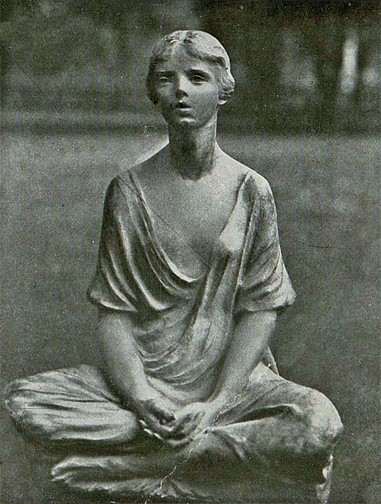
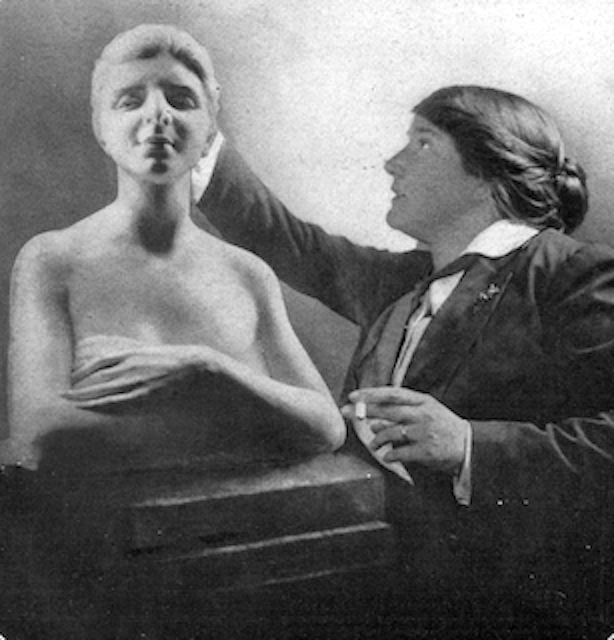
Born on July 15, 1878 near Bryn Mawr, Pennsylvania to lawyer John and Mary Watts, Anna Coleman Ladd was a self-styled sculptor who shied away from formal training in art schools. Instead, she drew and modeled from life. She claimed that the start of her career as a sculptor began at an early age when she modeled figures with window putty left by a repairman (“Notes”). To prepare for her work as a sculptor, she followed courses in literature, comparative religion, anatomy, architecture, and design (“Draft Biography”).
Ladd spoke 4 languages and lived in different parts of Europe for close to 25 years (“Mrs. Ladd, Sculptor, Novelist, and Dramatist” 7): Rome, Paris, and Vienna, where her grandfather was the U.S. Minister to Austria (“Notes). She mainly worked in private studios, receiving criticism from such sculptors as Ettore Ferrari and Emilio Gallori in Rome, Marius Jean Antonin Mercié and Auguste Rodin in Paris, Charles Grafly in Philadelphia, and Bela Lyon Pratt in Boston.
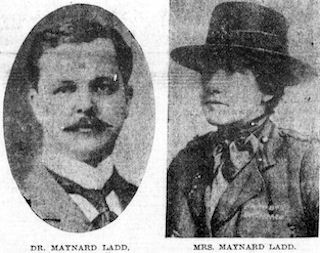
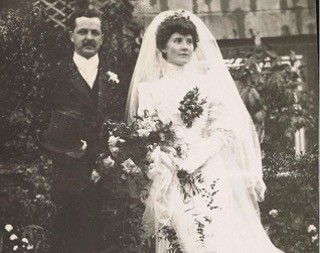
On June 26, 1905, she married Dr. Maynard Ladd, a specialist in the diseases of children, in England's Salisbury Cathedral. They moved to Boston, where Maynard joined the Harvard Medical School faculty and Anna continued sculpting while raising their two daughters, Gabriella May and Dorothy Vernon, whom she sometimes used as models for her work (Mrs. Ladd, Sculptor, Novelist, and Dramatist” 7).
When asked about her daily life and activities, Anna Ladd responded:
I am not a suffragist [...] nor a club woman, nor a follower of anything; but I have the characteristics of the beaver who, when not working, is, I hear, the idlest fellow alive (“Sculptor and Author”).
Ladd was prolific and communicated with the world through her art: “As a sculptor I have expressed myself in bronze and not in words” (“Anna Coleman Ladd Explains [...]”). During the first two decades of the twentieth century, she produced joyful bronze fountain figures for private gardens (e.g. "Sun God," "Leaping Sprites," “Triton Babies”), executed several portrait busts (e.g. Mrs. Handyside Cabot, Eleanora Duse, Anna Pavlova, Ethel Barrymore), and also wrote two lengthy novels, Hieronymus Rides (1912) and The Candid Adventurer (1913), which received positive reviews and wide press coverage in the U.S.
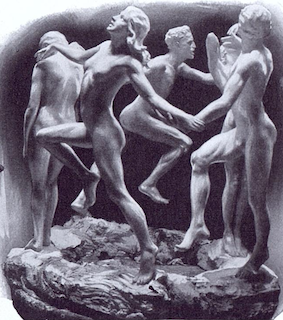
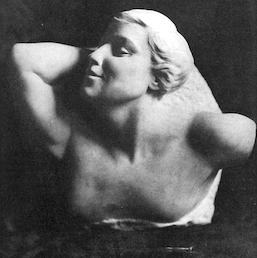
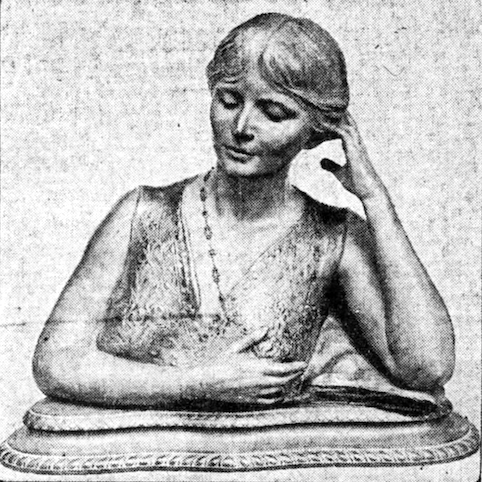
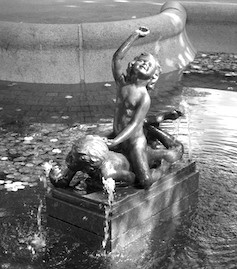
Ladd once said of her sculptures, "My dream is to work for all outdoors, to produce sculpture to be placed on street corners, on walls, on the open roads" (Seaton-Smith 251). In an April 12, 1915 interview for the Kansas City Times, she bemoaned the artless sculptures that covered the east coast of the United States:
Instead of catching these men in their heroic, inspirational years, in action and aflame with the spirit which made them worth remembering, they have been shown to you as they were the day they died, the fires cold, the face wearied, the figure in a lifeless repose; mere shells of the men they were. The East is overrun with these dull, conventional, artless figures. They are dead things. But the past ten years have been fruitful ones for American sculpture. A boy may look at some of the newer work and catch the spirit of the man it typifies and the inspiration of his achi;evement (2).
Between 1907 and 1916, Ladd showed her work at the Gorham Gallery in New York, the Corcoran Gallery in Washington D.C., The Guild of Boston Artists, and the Pennsylvania Academy of the Fine Arts in Philadelphia. She also exhibited in Rome, at the Salon des Beaux-Arts, the Art Institute of Chicago, the Boston Museum of Fine Arts, the National Academy of Design, and the National Sculpture Society. Sixteen of her bronze fountain figures were also shown at the 1915 Panama-Pacific Exposition in San Francisco, for which she earned an Honorable Mention.
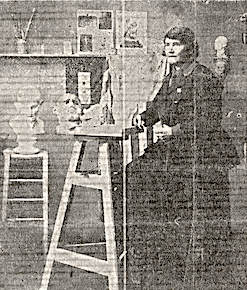
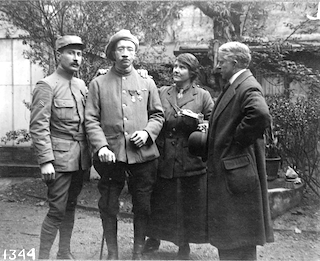
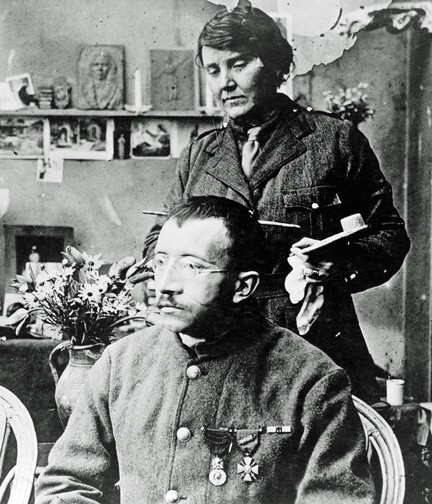
When the Allied Forces joined the war effort in 1917, Ladd decided to put her artistic skills to practical use as a volunteer for the American Red Cross. Leaving her children with their grandparents, Ladd moved to Paris after her husband was appointed Deputy Commissioner of the Children's Bureau of the American Red Cross in Toul, where he served as its medical adviser in the dangerous French advance zones.
She established the Studio for Portrait Masks in Montparnasse and traveled throughout France, convincing surgeons to support her initiative. The Studio was a resounding success, earning praise from French surgeons and soldiers alike and receiving wide press coverage in the U.S. Despite her achievements, Ladd decided to return to Boston in early December 1918, leaving the studio in the hands of the Red Cross and the artists who had worked with her in Paris. Her husband also returned to Boston and reopened his medical practice.
Although Red Cross officials encouraged her to establish a similar studio in the United States (Gibson letter to Ladd, July 23, 1918), Ladd chose not to continue the work she had so successfully accomplished in France and resumed her career as a civilian artist.
Working mainly in Boston and Beverly Farms, Massachusetts, she converted an old horse stable into a studio she called "Arden." In the 1920s and 1930s, she executed portrait busts, reliefs, fountain figures, and symbolic statues that generated praise and, sometimes, public indignation (e.g. “Wind and Spray,” “New Conception of Christ”). In the 1930s, she also developed her technique for coloring marble, plaster busts, and reliefs in the manner of French, Italian, Spanish, and Greek sculptors (“Artist Application Form [...]”).
The magnitude of the suffering Ladd had witnessed in WWI had a significant impact on her art. Many of her sculpted figures or bas-reliefs evoked the horrors of war: “Dawn on the Battlefield,” “Night in the Trenches,” “Sacrifice” (Allbright Art Gallery, 1923). She also designed memorial tablets and several war memorials: Studebaker Memorial in South Bend, Indiana; the Aldrich Memorial in Grand Rapids, Michigan; and the Russell Memorial in Andover, Massachusetts; two memorials for the American Legion, one commissioned by the Manchester-by-the-Sea Legion; the other entitled, Cost of Victory, in the American Legion Lot in the Beverly Farms cemetery.
During this period, Ladd was granted an honorary Master of Arts degree from Tufts University (1923). She was also a frequent guest speaker at women’s clubs, art associations, and museums, where she discussed the role of artists, her work during the war, and the challenges of being a sculptor.
In her address at a Plaza Hotel dinner for the American Women's Association Club on May 5, 1925, Ladd characterized the sculptor's obligations as follows:
"Sculptors, to be any good at all, have to touch all sides of life. They deal in material and in spirit. The grace of the figure they model is based on the accurate mechanism of armatures. They must have the physical strength of a blacksmith, the skill of a carpenter, the precision of a dentist, the knowledge of anatomy and psychology of a physician. Not only this but they must have training in archaeology, mythology, history, and architecture, for the relation of the part to the whole is of the most vital importance in sculpture. [...] they must have the soul of a poet and the creative energy of a god [...]" (Address delivered at the Plaza, 5 May 1925).
Interestingly, the noted French sculptor Antoine Bourdelle echoed these sentiments in 1926 at his workshop in the Académie de la Grande Chaumière:
“Bourdelle said to-day—during his criticism at the Chaumière—‘A sculptor must be the composite of many contrary things. He must have the knowledge of a philosopher, the simplicity of a child—the soul of a poet and the science of a mathamatician [sic].’ Something to live up to, n’est pas?” (Gregory 95).
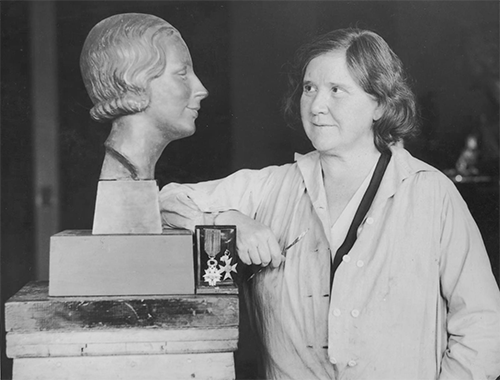
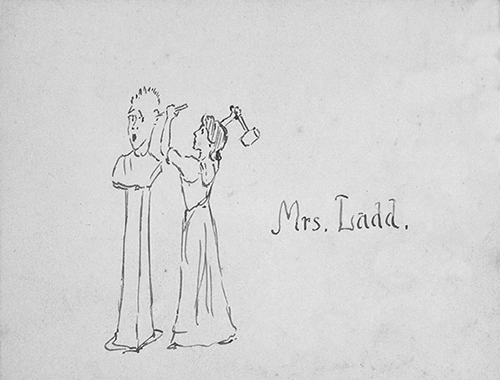
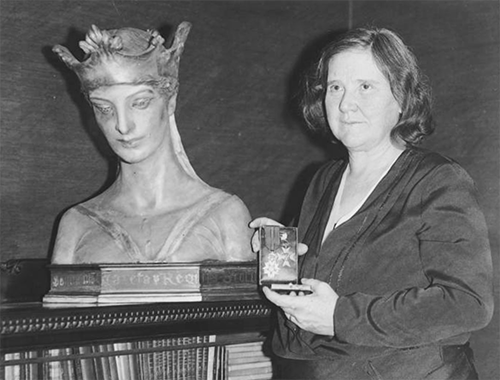
Ladd was made Chevalier of the Legion of Honor in 1934 in recognition of the Studio for Portrait Mask’s contributions to the well-being of French veterans. Some newspapers, like the Ledger-Star, claim she actually received the medal in 1932. She also was a recipient of the Serbian order of St. Sava (n.d.) and was a member of the National Sculpture Society in New York, the Boston Society of Artists, The Grand Central Arts Association, and Cosmopolitan Club (“Untitled Biographical Information”).
Anna Ladd died after an illness of several months on June 3, 1939 at the age of sixty-one, shortly after she and her husband had moved to Montecito, California (“Anna Coleman [...] Dies”). Several of her sculptures had been shown at the Faulkner Gallery in Santa Barbara in July 1938 (E.K.).
Maynard Ladd joined their daughter in Ontario, Canada in May 1941 and died shortly after in 1942 (“Dr. Maynard Ladd [...]”).
Anna Coleman Ladd's papers can be accessed at the Smithsonian Archives of American Art.
Consult the sources on Anna Coleman Ladd.
Marie-Louise Brent
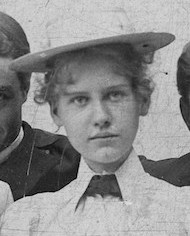
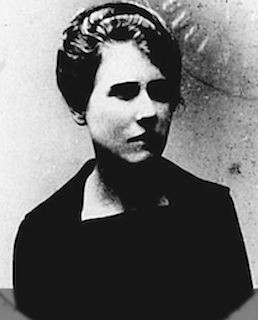
Born in Columbus, Ohio in 1878, Marie-Louise Brent (sometimes her name is spelled Mary) was a sculptor who spent most of her adult life in Paris. A graduate of the Vassar College class of 1900, she had also studied in Italy and Switzerland. As an artist, Brent was primarily trained at the Académie Colarossi by Jean-Antoine Injalbert and Paul Bartlett.
In 1914, Brent was living at 9 rue Campagne-Première. She joined the Red Cross, serving on the American Board of Administration of the American Fund for French Wounded, which had been approved by the French government (“What the AFFW has Accomplished”). In this capacity, she helped collect funds for the relief of French soldiers and also organized and distributed “comfort bags” to soldiers leaving for the front from Gare du Nord in Paris. Dubbed as “blue bags” because they were made from the same cloth as the French military uniforms, they contained warm stockings, handkerchiefs, a tin plate, preserved fruit, cigars, paté, mustard, and jam. Each bag also included a card with crossed American and French flags symbolizing unity and with the following message: “With best wishes of [sic.] your friends of the United States. Vive la France (in all caps) (“The French Soldier’s Blue Bag”).
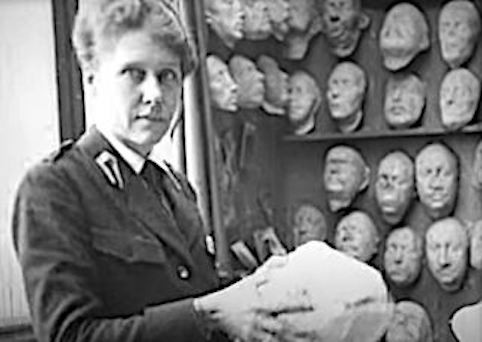
Brent joined the Studio for Portrait Masks in September 1918, around the same time as Wlérick. She became the Studio's secretary (Mitchell 40), overseeing day-to-day administrative logistics, correspondence, and finances. Since Anna Ladd was often absent, managing the studio was an important responsibility for Brent especially since visitors often toured the Studio and soldiers gathered there socially. She was a sculptor of some repute but it is unclear if, under Ladd’s watch, she also contributed to modeling or painting masks. When Ladd returned to the U.S., the Red Cross leadership appointed Brent as director of the Studio, and she was charged with carrying forward the project that Ladd had so masterfully initiated. While masks continued to be delivered, and the Studio was still a gathering place for soldiers, Brent did not have the same reach or impact as Ladd. She also encountered difficulties with the allocation of resources and space. She resigned on November 1, 1919 after having shipped plaster casts to the ARC museum in an effort to memorialize the Studio.
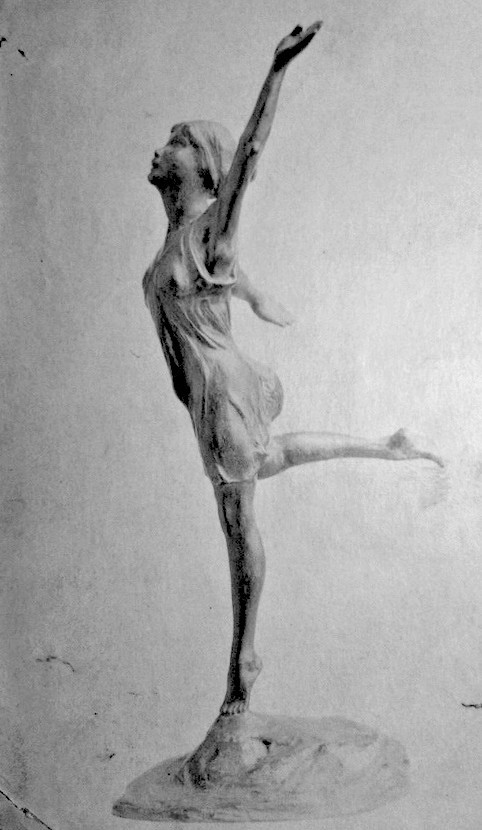
On November 18, 1919, Brent married military historian and archivist Charles Louis Albert Depréaux (“Ohio”), librarian and vice president of the Fondation Thiers (“History of Irish Brigade”).
Brent had exhibited her sculptures at the 1913 and 1914 AWAA exhibitions at 4 rue de Chevreuse. Her 1913 entries are unknown but her statuette of a woman was praised at the 1914 show and was likely the same work she had exhibited at that year’s Salon des artistes français. In the 1920s, she exhibited a number of her sculptures at the Salon des Indépendants, mostly terracotta nudes of women, a genre for which she became known. Brent occasionally exhibited her sculptures under her husband’s name, leading to some confusion in the art historical record (he is erroneously listed as a male sculptor born in Columbus, Ohio in many reference works, including the Benezit Dictionary of Artists).
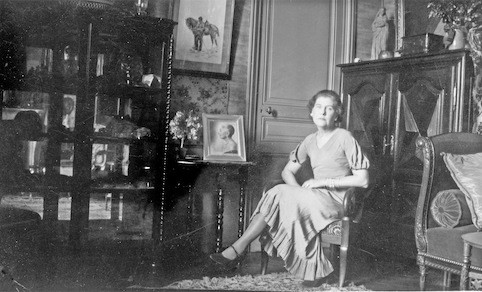
Brent appears to have remained in France, living with her husband at the Fondation Thiers in Paris and spending time in the French countryside. A diary she kept and sent to her sisters during WWII details the vicissitudes of everyday life in Brittany and Paris during the German occupation from 1940 – 1944: struggles in her quest for food and other supplies; confrontations with German soldiers; her health and that of her husband; assisting other families impacted by the war.
She died in Paris on June 2, 1963.
Sources
- “Good Cheers in the Trenches.” St. Louis Post-Dispatch. May 16, 1916, p. 14. Newspapers.com.
- “History of Irish Brigade Will Soon be Made Available.” Our Sunday Visitor, November 7, 1924, p. 1.
- Michell, Caroline. “Facing Horror: Women’s Work, Sculptural Practice and the Great War.” In Mainz, Valérie and Griselda Pollock. Work and the Image: v. 2: Work in Modern Times - Visual Mediations and Social Processes, Routledge, 2018, pp. 33-59.
- “Ohio.” The Cincinnati Enquirer, November 30, 1919, p. 75. Newspapers.com.
- “Society of Men Who Have Scars.” The Charlotte News, February 12, 1920, p. 4. Newspapers.com.
- “Tells Gripping Details of War.” The Indianapolis Star, November 16, 1918, p. 9. Newspapers.com.
- “The French Soldier’s Blue Bag.” The Virginian-Pilot, 25 november 1916, p. 6.
- “Thrilling Experiences of a Woman in France.” The Marion Star, October 20, 1917, p. 10. Newspapers.com.
- "U.S. Women Hold Sculpture Exhibit." The Inter Ocean, April 12, 1914, p. 18. Newspapers.com.
- “What the AFFW has Accomplished.” The St Joseph Observer, September 7, 1918, p. 7.
Jane Poupelet
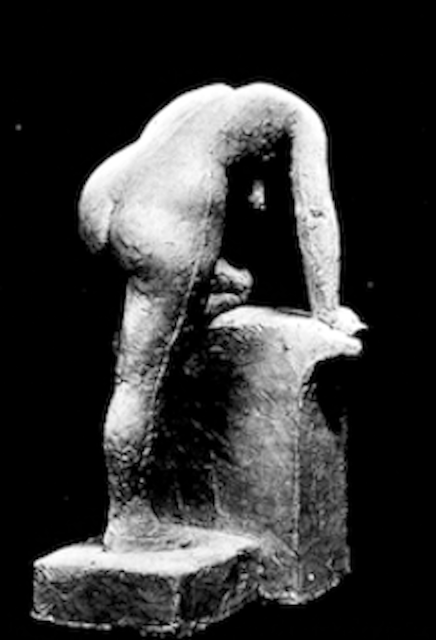
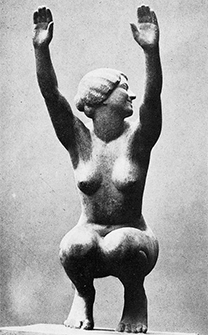
Marie Marcelle Jane Poupelet, whose work had been largely forgotten in the aftermath of WWII, was critically acclaimed in her day. Today, she is recognized as one of France’s foremost sculptors and her works can also be found at major museums in the United States, including the Metropolitan Museum of Art (“Femme à sa toilette,” and several drawings), the Brooklyn Museum of Art (“Femme assise,” several drawings), the Art Institute of Chicago (several drawings). A retrospective exhibition was held in several French museums between 2005 and 2006 (La Piscine, Roubaix; Musée des beaux-arts, Bordeaux; Musée Despiau-Wlérich, Mont-de-Marsan), with a comprehensive catalog of her works, including several articles about her life and career (Rivière).
At a time when women sculptors faced untold barriers and prejudices, Poupelet diligently pursued her calling, initially submitting her work to galleries and Salons, as many women artists did, under a man’s name:
The fact that a woman can knead clay and wield hammer and chisel with vigor is surprising and disconcerting at first. Sculpture is not the work of a lady. There are many ladies who do their best, however. But their work, which has grace, sometimes, is still lacking in robustness, grandeur, and style. So much so that we are astonished that, by defying all anti-feminist prejudices, the art of Miss Jane Poupelet has precisely these qualities of style, grandeur, and robustness until now considered to be an exclusively male prerogative (translated from French, Pays 4).
Born on April 18, 1874, the daughter of a lawyer and government official, Poupelet grew up in the small village of St-Paul-Lizonnes in the Périgord. Although her parents initially did not approve of her artistic endeavors, they later provided her with full moral and financial support (“À propos de Jane Poupelet”).
She began working with clay at a very young age, modeling farm animals and caricatures of her relatives and friends (Myra 1). After spending several years in a boarding school, she was the first woman admitted to the École des Beaux Arts de Bordeaux (1892). There, she studied under a certain Mr. Braquehaye and received a diploma as a drawing professor in May 1892 (Diplôme 3); she also attended anatomy and dissection classes at the Faculté de médecine de Bordeaux (Rivière 142). Since her parents, who initially did not approve of her career choice, had cut off her financial support, she taught drawing classes and sold her own works, gathering enough money to go to Paris in late 1896 (T.S. 4). She attended the Académie Julian for a month and a half in Denys Puech’s atelier (Martinie 88), but was dissatisfied and went back to Bordeaux. According to Rivière, she settled in Paris around 1900. In Bordeaux, she briefly met French feminist Hubertine Auclert and would later move in Anglo-Saxon feminist circles in Paris.
In this period, Poupelet worked for three years in the Paris atelier of Lucien and Gaston Schnegg, whom she had met earlier and for whom she had great admiration (Martinie 88). She also posed for Lucien, who executed a plaster cast of her portrait bust (completed in 1901), now at the Musée d’Orsay. The cast led to several iterations: one in marble (shown at the 1903 Salon and then exhibited at the Luxembourg museum in 1904); others in lost-wax bronze with black or gold patina (Musée des Beaux-arts de Bordeaux).
Poupelet began her career under the male pseudonym Simon de Lavergne, which was the last name of cousins of her mother (Rivière 18). Between 1898 and 1901, she submitted work to the Salon des Beaux Arts under this pseudonym (Lepoittevin; Myra 1). Poupelet won the silver medal for a “decorative vasque” at the 1900 Salon, which members of the jury thought they were awarding to Simon de Lavergne (Myra 1).
Lucien Schnegg was impressed by her talent and told her she had no need for an instructor (Guillemot 52). Boosted by his support, she began exhibiting under her own name. In 1904, she participated in a Schnegg atelier show at the Galerie Barbazanges. When Lucien died in 1909, she stayed in close contact with his brother Gaston, remaining part of the group of young independent sculptors dubbed by art critic Louis Vauxcelles as the “bande à Schnegg.” While they did not constitute a real movement, the group worked in or gravitated around the atelier. It included such artists as Charles Despiau, Alfred Jean Halou, Léon Drivier, Henry Arnold, Louis Desjean, François Pompon, Albert Marque, Yvonne Serruys, and Robert Wlérick.
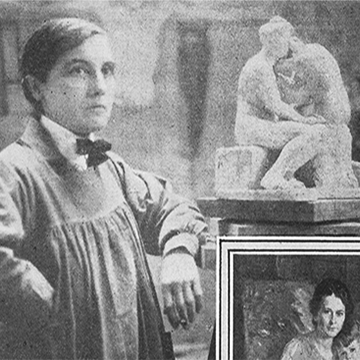
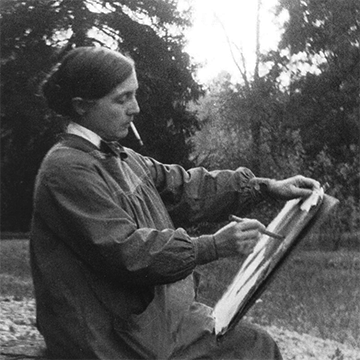
In November 1902, Poupelet moved to 30 rue Dutot near the Institut Pasteur, in the same street as the Schneggs (40 rue Dutot) and Wlérick (36 rue Dutot) (Rivière 143). She remained at this residence and atelier for many years. The area was still quite rural and the property was teeming with her favorite animals – cats, rabbits, chicken, and ducks (Briot 84, note 322):
In the suburbs [the 15th arrondissement!], she owned a small, curious house where the most diverse animals lived in good intelligence. She loved animals. In her admirable works, she entrusted them with a particularly moving and prestigious nobility. Her bronzes, her drawings, were inspired by an ardent understanding, an exquisite grace, a deep truth (F.A.11).
During the summer months, she stayed at her farm/studio, near her family home, the Château la Gauterie, which had been built for her grandfather in 1860 (now a hotel and wedding venue) (Kunstler 1932, 5). Having reconciled with her parents, she once again benefited from their financial support (“À propos de Jane Poupelet” 5). According to Briot, she lived alone and had no children, “her artistic career and feminist commitment made partly possible by renouncing marital life” (translated from French, 56). From 1904-1909, she also had an atelier at 14 ave du Maine, near Fernand Léger and André Mare (Rivière 143).
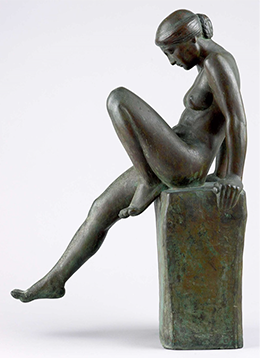
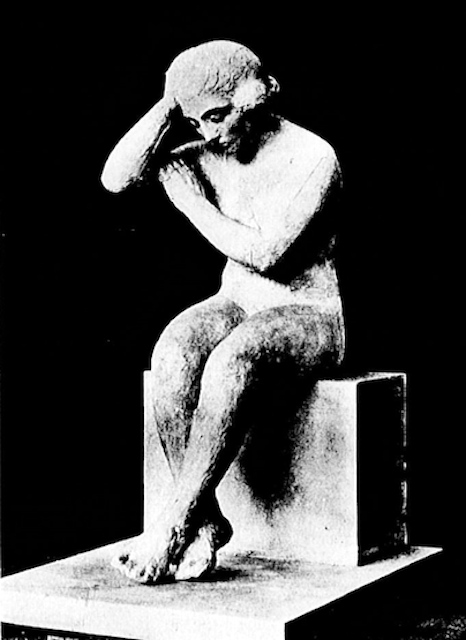
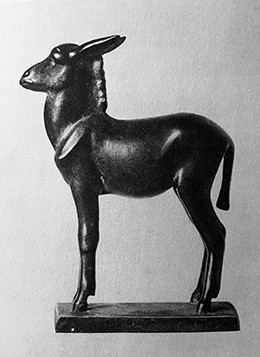
In 1904, Poupelet showed four of her sculptures at the Salon des Beaux Arts, including “Enterrement à la campagne,” which was acclaimed by both critics and the public (Martinie 88). She was awarded a travel grant by the Société Nationale, and toured Italy, Sicily, Tunisia, Algeria, and Spain between 1904 and 1905 (Pays 4; Martinie 91), accompanied by painter Charlotte Chauchet (Rivière 143). Her contact with Greek and Egyptian sculptures seems to have had a strong impact on her future work.
She continued exhibiting in various Paris salons and galleries until 1912 (see Rivière’s list of exhibitions, pp.148-155).
Her sculptures and drawings fall into two main categories: female nudes and domestic or farm animals, always in movement or repose. Drawings were an important part of her sculptural work: she began drawing from life the different poses taken by animals or women, initially producing single copies of figures that she plunged in bronze but chased and patinated herself (Lepoittevin). She is known for her relentless and meticulous work, always insisting on the faultless quality of the final product (Martinie 96):
Always dissatisfied, when she sculpts, she imposes a whole series of tasks on herself. Once her sketch is completed and molded, she compares the plaster figure to her model, constantly correcting it by observing it. She then looks for the fitting and the subtle passages of the modeling, and places the details accordingly. She also focuses on the plays of light because she wants her statue to seem like she made it all at once, to form one block (translated from French, Kunstler 1930, 9-10).
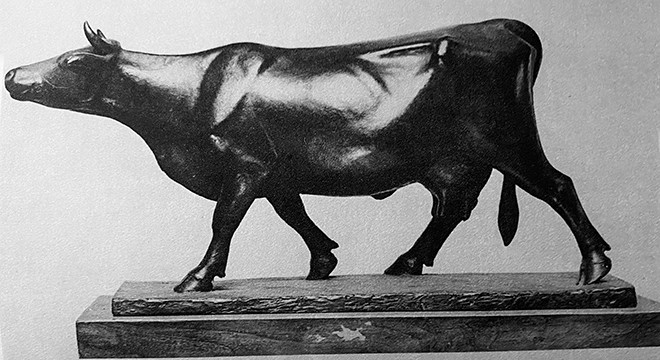
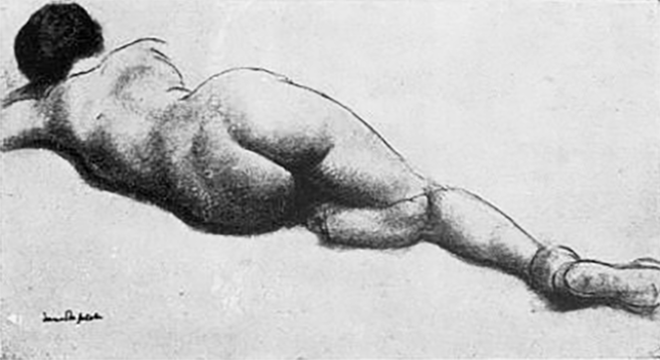
Poupelet came into contact with Auguste Rodin and was close to Antoine Bourdelle. She also socialized with American women artists who came to Paris at the turn of the century, among them sculptors Malvina Hoffman and Janet Scudder, and painter Elizabeth Nourse, who were all associated with the American Girls’ Art Club at 4 rue de Chevreuse. A chance meeting around 1911 brought Poupelet into contact with Scudder, who would later play an important role in her career:
While living in the Rue de la Grande Chaumiere, I made one of my best friends among the French people - a friendship which has increased with the years and which has had something to do with the appreciation of modern French sculpture in America. Our meeting came about in a rather entertaining way. I happened to look in at an exhibition one day and came across a little bronze, a really superb piece of work representing nothing more important than a rabbit – but something that appealed to me at once as being a very beautiful work of art. I bought that rabbit on the spot – the only piece of sculpture I have ever bought – and gave my address for its delivery at the close of the exhibition. A few days later my servant brought a card up to the studio - the card of Mademoiselle Jane Poupelet, sculptor of my precious rabbit. She explained that she had called to have a look at an artist who had bought the work of another woman artist […] Returning her visit almost immediately, I found, in her studio in the Rue Dutot, a collection of small bronzes that convinced me that Mademoiselle Poupelet was one of the most important sculptors of our times (Scudder 237-238).
Scudder was actually responsible for introducing Poupelet to collectors in the United States. She brought seven of her sculptures to New York in 1913, where the female figurines and small animals enjoyed immediate success after The Metropolitan Museum of Art bought Poupelet’s “Femme à sa toilette.” News articles about Poupelet’s work proliferated, and Scudder even wrote an article in Harper’s Weekly in praise of her friend. “Femme à sa toilette” was exhibited at the famed Armory Show (February-March 1913), alongside works by Aristide Maillol, Wilhelm Lehmbruck, Constantin Brancusi, etc. (Briot 112).
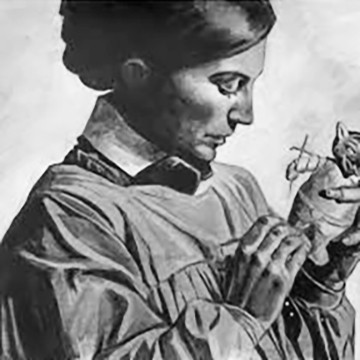

With the onset of WWI, Poupelet created several series of wooden toys and rag dolls, which were sold at the Union Centrale des Arts décoratifs in 1916, the Pavillon de Marsan in 1917, and the Galerie Devambez in 1918. The proceeds of these sales were sent to help the war-stricken (Briot 98).
Poupelet met Anna Ladd through the American Red Cross and joined her in March 1918 to work at the Studio for Portrait Masks. Janet Scudder’s former atelier became the epicenter of this Studio. Poupelet brought in Robert Wlérick, who had been working with a facial surgery unit in Bordeaux. “Poupelet and Wlerick worked on a part-time basis of five hours a day, to enable them to pursue their own career as sculptors, for a salary of 450 francs a month” (Mitchell 53, note 35).
In his article on Poupelet, Eric Dussourt elaborates on her duties, which demanded more than fashioning masks, especially since she also had to manage the Studio during Ladd's frequent absences:
Jane Poupelet oversees the administrative and financial part of the business. Her job at the mask workshop is entirely voluntary and occupies her every afternoon, six days a week. She receives a monthly allowance of 400 francs for her professional purchases, without having the right to meals and accommodation like volunteer nurses (translated from French, 14).
When the studio was transferred to the Val de Grace hospital, Poupelet continued working on portrait masks until ca. 1920. For her contributions to the war effort, she was made Chevalier de la légion d’honneur in 1928. In addition, she joined the French League of Friends of Animals, campaigning against vivisection and animal abuse (Briot 99).
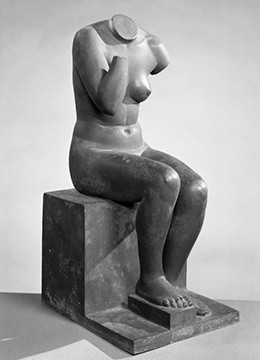
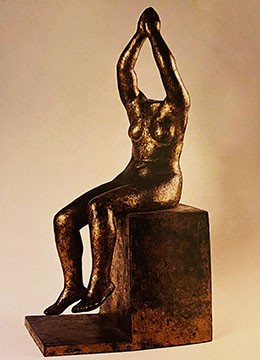
After the war, Poupelet resumed sculpting animals and women, notably removing arms, hands, or heads from some of her figures (e.g., “Imploration” or “Femme assise”). While art historians claim she sought to “emphasize the form rather than the subject itself,” one cannot help wondering if her experiences with disfigured soldiers had an impact on her work (Briot 81).
In 1921, she was elected as President of the Société Nationale des Beaux-arts and exhibited at the 1922 and 1923 Salons (“Jeune fille baissée” and “Femme endormie”). In addition, she continued to advocate for women’s education, especially in the arts, and joined the International Federation of University Women, giving a paper on “French Feminine Art” at their 1922 inaugural conference, which took place at the Sorbonne and 4 rue de Chevreuse (Briot 92; Monod 212).
In 1923, she withdrew from the Société Nationale in a rejection of its old-fashioned ideology. Together with Edmond Aman-Jean, Antoine Bourdelle, Albert Besnard, Charles Cottet, Charles Despiau, Henri Lebasque, René-Xavier Prinet, Lucien Simon, and other avant-garde artists, they founded the Salon des Tuileries, where young artists were invited to show their work (G.-B. 18-19; Briot 109). The famed critic Louis Vauxcelles echoed the dissenting voices in a caustic article describing the other Salons as “retirement homes for quavering tenors; not having been able to keep the young, they exhale an odor of decrepitude and mustiness (translated from French, 2).
An inveterate smoker, Poupelet’s pulmonary ailments forced her to abandon sculpture 1925 and limit herself to drawing. She did continue to exhibit her sculptures and drawings, earning critical praise in both France and the United States. In 1925, she and four other sculptors associated with the Société des peintres et des sculpteurs (originally founded by Sébastien Mourey in 1899) were selected to represent five facets of French art at the Exposition Internationale des Art décoratifs et Industriels Modernes (1925): Jane Poupelet – grace, Louis Dejean – meditation, Charles Despiau – simplicity, Jean Halou –strength, and Robert Wlérick – suffering (Briot 74). In 1928, she exhibited 11 sculptures and 48 drawings at the Galerie Bernier, with a catalog written by Vauxcelles (Rivière 146).
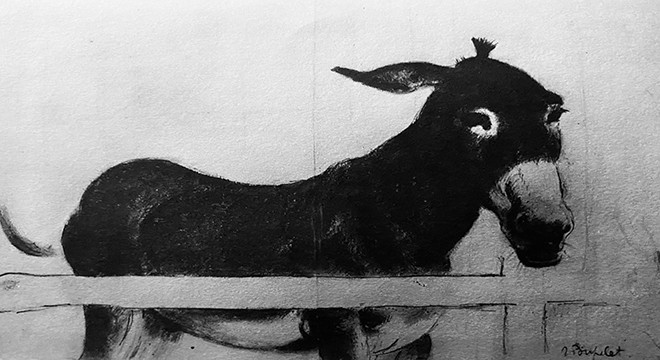
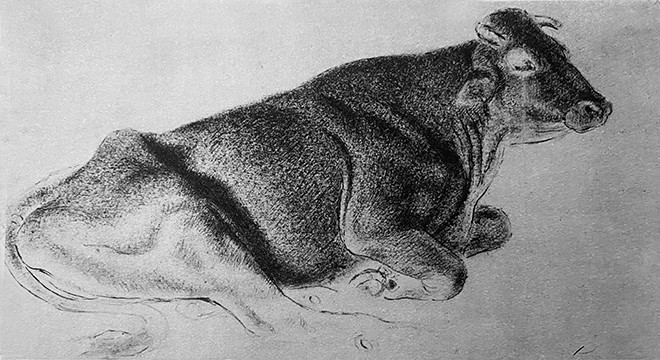
According to Jacques Tcharny (2-5) of the Galerie Nicolas Bourriaud, Poupelet joined forces in 1931 with the animal sculptor Pompon, in creating the “Groupe des XII” at the Jardin des Plantes, where Pompon had brought together young animal sculptors who studied natural models. The group comprised: Pompon, Jouve, Guillot, Poupelet, Chopas, Margat, Hilbert, Profillet, Saint-Marceaux, Jouclard, Artus, and Lemard. It continued to be active even after the death of Poupelet in 1932 and that of Pompon in 1933, until the onset of WWII. Poupelet exhibited her “Anon” in the 1932 (April 8 to May 7) exhibition at the Hotel Ruhlman (3). A second exhibit took place at the Hotel Ruhlman in 1933 (March 1-31), where Poupelet was honored with a special display that also included Schnegg’s portrait bust (8). Her animal drawings shown at the Montross Gallery in New York (1931) were quite favorably reviewed by a critic of The New York times:
Jane Poupelet, well-known French sculptor, is the attraction at the Montross Gallery. This time drawings are most in evidence, and, as one would expect, animals predominate as subject matter. Apparently Mme Poupelet knows as much about cows as she does about horses. There are some miraculous cows in this show. Her studies of nudes hold their own, but it is the cows that really win your heart. We have yet to see them in the round, but no doubt that pleasure is in store. The small nude sculptures are not very impressive. One called “Imploration” [see above photo] will probably create a bit of a stir; it is persuasively gilded and no doubt every word that may be uttered regarding the sculptural soundness of every line is true; but why couldn’t the woman’s head have been somehow added? Without it she looks so forlorn, much more bereft than were she just a torso (Jewell 36).
Another critic’s perspective on the same exhibit is also worthwhile quoting for her innate understanding of Poupelet's gaze and technique:
Mme. Poupelet has a farm we are told, and goes there for her models, who cease to be models the moment she bends her sympathetic glance upon them. Sympathetic yet amused. Nothing quite downs that upwelling fountain of humor that finds the most legitimate avenues of escape – in the cocked-down ear of a rabbit, in the matinee hero aspect of an ox, long-lashed and sleepy-eyed; in the cocked-up tail of a duck and the pompous front of a pigeon. The drawings gossip of these differentiating attributes as country neighbors gossip of each other, on the basis of complete familiarity. The method used in the drawings is not unlike that of the sculptures. There is no attempt to say everything in one synthetic line. On the contrary, the rich sepia, sanguine, or ink emphasize bulk and fullness, giving the effect, the maximum of weight with a minimum of detail (Cary, 18).
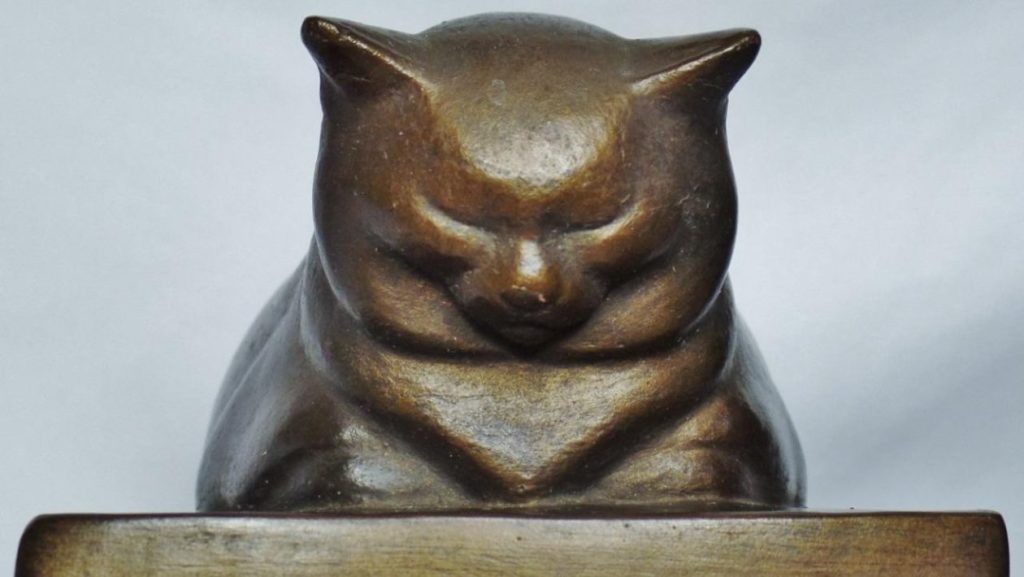
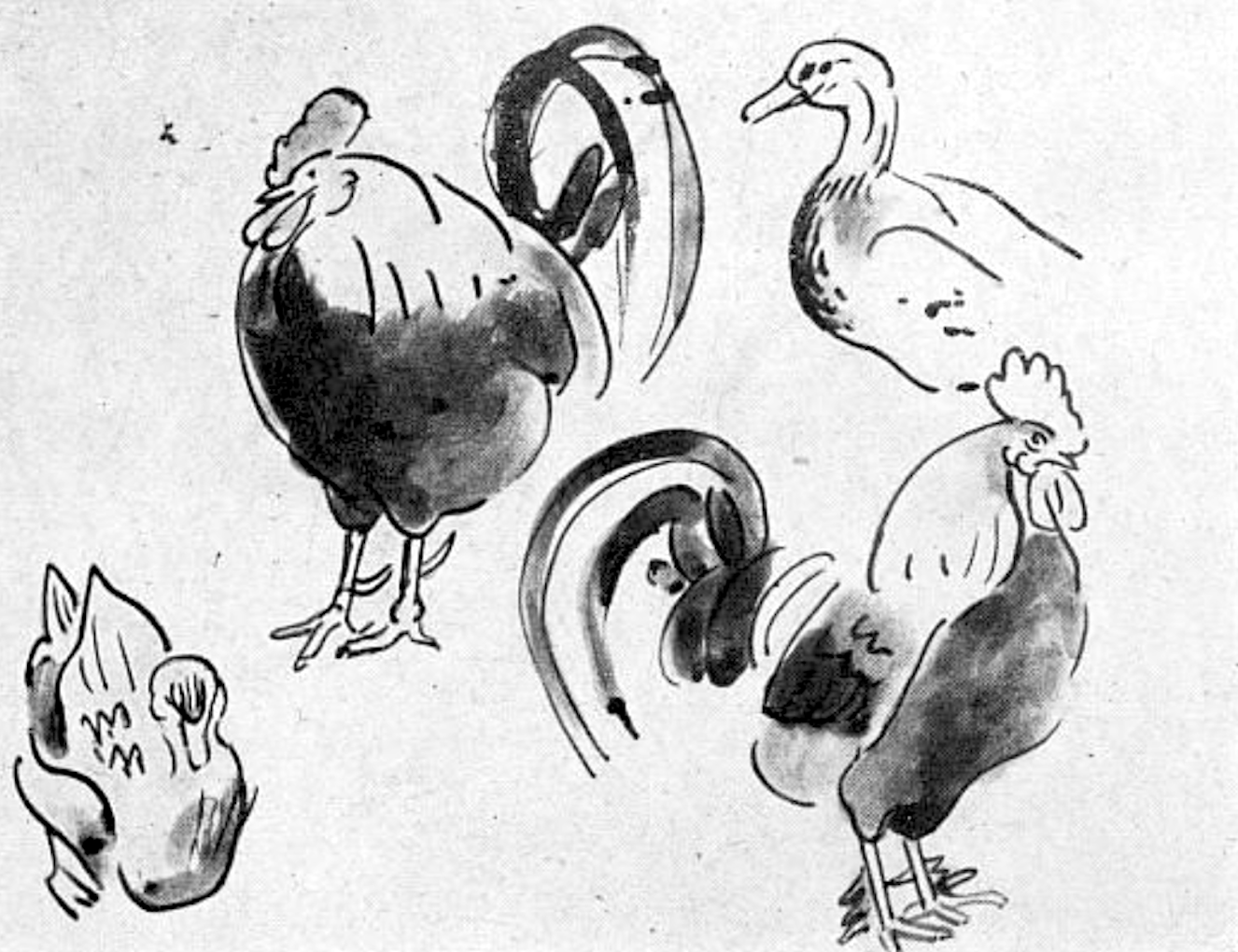
Jane Poupelet died in Talence on October 17, 1932 and over one hundred artists organized a memorial service in her honor at the Église Notre-Dame-Des-Champs in Paris on December 19. Dozens of articles in French journals and magazines extolled her drawings and sculptures, though only passing references were ever made to her contributions to the war effort.
Poupelet's family donated 64 drawings and 15 sculptures (13 bronzes, 2 lead) to the Musée du Luxembourg, which had previously acquired two of her sculptures ("La Femme à la toilette" and "La vache marchant") and 3 drawings (de Laprade 4). The museum organized an exhibition of these works in January and February 1935, which prominently displayed Schnegg’s portrait bust of Poupelet (Ladoué 43; de Laprade 4; Poulain 3). Many other exhibits in New York, Chicago, Paris, Bordeaux, Prague, Barcelona followed, including three large exhibits in Périgeux in 1949, at the Musée Rodin in 1959, and at the Musée Bourdelle in 1974.
The Brooklyn Museum held a memorial exhibition of her sculptures and drawings in March 1933, the first of its kind in honor of a French sculptor. Works were lent by the Metropolitan Museum of Art, the Art Institute of, and by private collectors such as Janet Scudder, Frank Crowninshield, Mrs. William Whitney, and Mrs. Stanford White ("Jane Poupelet” 56).
In his obituary, art critic and journalist René-Jean (René Hippolite Jean) draws a gracious portrait of Poupelet:
It is with stupor that artists will learn of the death of Jane Poupelet, who disappeared suddenly, in full force, when one could have expected to see her add to her work and enrich it for a long time. We will no longer see her, in her slim and small silhouette, a little boyish in appearance, cast an attentive eye during exhibitions. Silent and charming in her delicate features, often with a cigarette hanging from her lips […] A powerful sketcher and a delicate sculptor have disappeared. French art is in mourning (translated from French, 2)
Consult the sources on Jane Poupelet.
Robert Wlérick
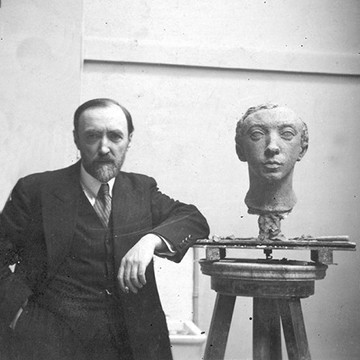
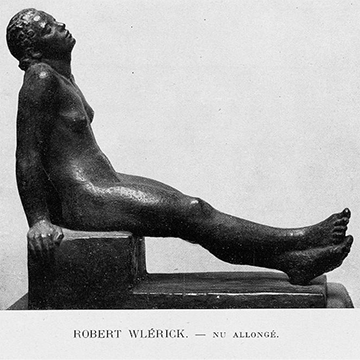
Robert Wlérick was a prolific sculptor (see catalog). A museum (inaugurated on July 21, 1968) is dedicated to his work and that of his friend, Charles Despiau, in their hometown of Mont-de-Marsan, France. Numerous articles and catalogs are devoted to his sculptures and drawings, yet not much is known about his life. Like his friend Jane Poupelet, Wlérick was modest about his art and private about his contributions to the war effort. In the words of Gustave Kahn: "His life has no anecdotes. He has no biography, only a list of works, one which gets richer every year" (45).
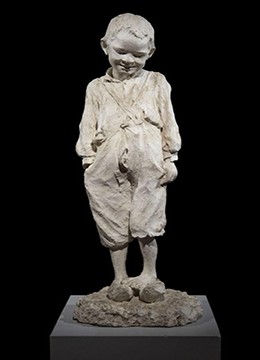
Born on April 13, 1882 in Mont-de-Marsan, France, Wlérick seemed destined for an artistic career from an early age. His father, like his Belgian grandfather, was a woodworker who owned a furniture store and sold antiques. By the age of 15, Wlérick was assisting in the family business, leaving the Lycée Victor Duruy, where, like Charles Despiau, he had followed the drawing classes of Louis Henri Ismaël Morin. The latter had detected Wlérick’s gift for sculpture and continued to give him lessons even after he left school. His plaster statue “Enfant aux sabots” is the only piece from this early period that he did not destroy. It was gifted by Morin to the Despiau-Wlérick museum, after Wlérick’s death in 1944.
In 1899, Wlérick entered the École des beaux-arts in Toulouse, where, for five years, he studied sculpture under Jean Alexandre Falguière (Ackerman 13), mainly working with wood (Kahn 45). After his military service, he went to Paris in 1906, where, through his friend Despiau, he joined forces with the “bande à Schnegg.” He settled in Paris in 1908 on rue Dutot in the 15th arrondissement, close to the atelier of the Schnegg brothers, and several doors down from Jane Poupelet. In the summer months, he would return to Mont-de-Marsan where he had an atelier on his family's property. He shied away from academic training at the École des beaux-arts, preferring to observe and sketch at the Louvre.
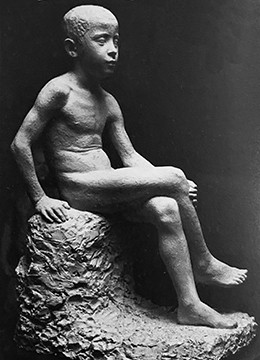
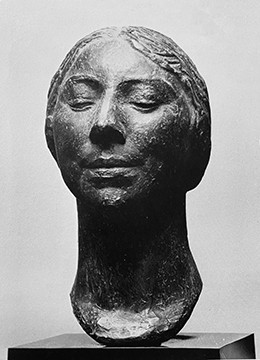
His earliest showing seems to be "Le petit landais" in 1907 at the Salon des Beaux Arts. From then on, he exhibited regularly at various Parisian galleries and Salons. His atelier was located at 14 rue François-Guibert, not far from that of painter and sculptor Berthe Martinie (Roudié 16), wife of the journalist and art critic Henri Martinie who wrote several articles about Wlérick's work in 1928 and later in 1948.
In 1913, Wlérick married Georgette Aldric, who modeled for him and with whom he had a son and two daughters. That same year he began teaching at the Germain Pilon school until the outbreak of WWI.

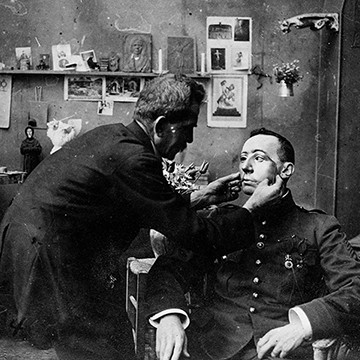
He was mobilized into the French military in 1914, and from 1915 to 1918 he worked in the facial surgery department of Bordeaux, which had been founded by doctors William Dubreuilh and Émile-Jules Moure. Moure consolidated all the medical services for facial wounds in 1916. To document and assist with the different stages of facial restoration, he also created several workshops led by artists: drawings and watercolors, Jean Dupas (Grand Prix de Rome 1910) and Christian Guindet; sculpting molds, Robert Wlérick, Edmond-Ernest Chrétien, and Charles Hairon; photography and stereoscopy, Jean Séréni. The Val-de-Grâce museum has preserved some examples of the artists’ documentation (Portmann).
Wlérick was brought into the Studio for Portrait Masks by Jane Poupelet, and he continued working there until September 1919. Other than Junka's article, "Le masque de gloire," describing his visit to the studio with Wlérick, there appear to be no extant sources highlighting his role at the Studio.
Wlérick later received commissions to sculpt war memorials in a number of French towns (Labrit, Morcenx, Saugnacq-et-Muret), and he continued exhibiting his plasters and bronzes at Parisian Salons and galleries.
Between 1922 and 1943, Wlérick taught at the École des arts appliqués à l’industrie (the fusion of the Germain Pilon and Bernard Palissy schools). In 1923, he left the Société nationales des beaux-arts and, with Antoine Bourdelle, Charles Despiau, Louis Déjean, Alfred Jean Halou, Aristide Maillol, Francois Pompon, and Jane Poupelet, participated in the creation of the Salon des Tuileries. He built an atelier in the 20th arrondissement of Paris (Roudié 17), far from the madding crowd of Montparnasse. Yet he was still part of the Montparnasse scene, since he replaced Bourdelle in 1929 at the Académie de la Grande Chaumière (Fondation Coubertin).
Wlérick was named "Chevalier" of the French Legion of Honor in 1926. In the 1930s, he traveled to Italy, and later built a vacation home in the Landes (Roudié 18). He participated in the 1937 Exposition universelle, with three commissions: "Pomone," "Zeus," and "L'Offrande," each dedicated to a particular pavilion on the exhibition grounds (Fondation Coubertin).
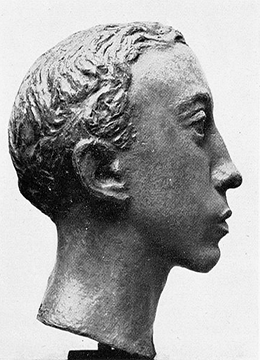
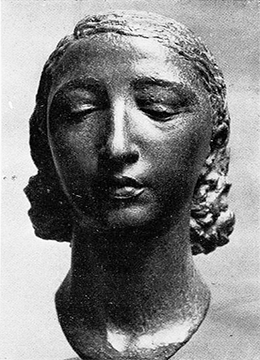
Robert Wlérick died of illness on March 7, 1944, just as he was about to complete a commission for a memorial to General Foch. The memorial was finalized by his disciple and co-worker Raymond Martin.
Wlérick’s wife continued to promote his work and participated in organizing a major retrospective of his sculpture with the painter Maurice Boitel at the Salon des Beaux Arts in the 1960s. In 1994, to commemorate the fiftieth anniversary of Wlérick's death, four French museums, including the Bourdelle museum in Paris and the Mont-de-Marsan museum organized an exhibition of his studies, sketches and drawings.
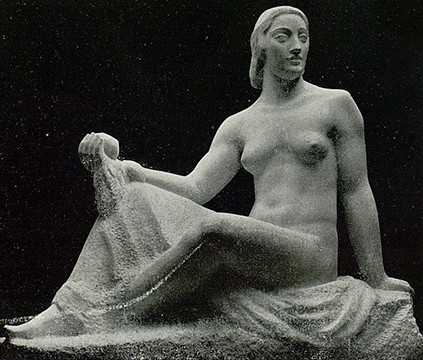
Sources
- Ackerman, Ada. "Redonner visage aux gueules cassées. Sculpture et chirurgie plastique pendant et après la Première Guerre mondiale." RACAR: revue d'art canadienne / Canadian Art Review, 2016, vol. 41, no. 1, 2016, pp. 5-21. JSTOR.
- “Exposition d’archives et de documents de guerre, d’oeuvres d’artistes mobilisés au Centre d’O.R.L. et de Chirurgie maxilo-faciale, 12 april-1 juin 1919.” Terrasse du Jardin-Public, Bordeaux. Gallica.
- Haurie, Béatrice. “Robert Wlérick.” Bulletin des Amopaliens landais, June 2009, pp. 13-14.
- Junka, Paul. “Le masque de gloire.” La Renaissance, vol. 7, no. 7, 29 March 1919, pp. 9-12. Gallica.
- Kahn Gustave. “Robert Wlérick.” L’Art et les artistes, vol. 28, no. 141, November 1933, pp. 44-49. Gallica.
- Marquis-Sébie, Daniel. "Robert Wlérick, Critique à l'atelier de sculpture de la Grande Chaumière." Revue des Arts, vol. 10, no. 159. August 1931, p. 12. Gallica.
- Placin-Gea, Amandine. “‘La ‘bande à Snegg’: examen d’un groupe de sculpteurs indépendants.” Histoire de l’Art, no. 53, November 2003, pp. 45-55. Persée.
- Portmann, Didier. "Émile Moure Pionnier de l'ORL moderne dès 1880." Première Journée d'histoire. de l'oto-rhino-laryngologie 20-21 novembre 2009. Biusante.parisdescartes.fr.
- "Robert Wlérick." Fondation Coubertin.
- Roudié, Paul. Robert Wlérick (1882-1944), catalogue for the 1982 Musée Rodin and Musée Despiau-Wlérick retrospective exhibitions.
